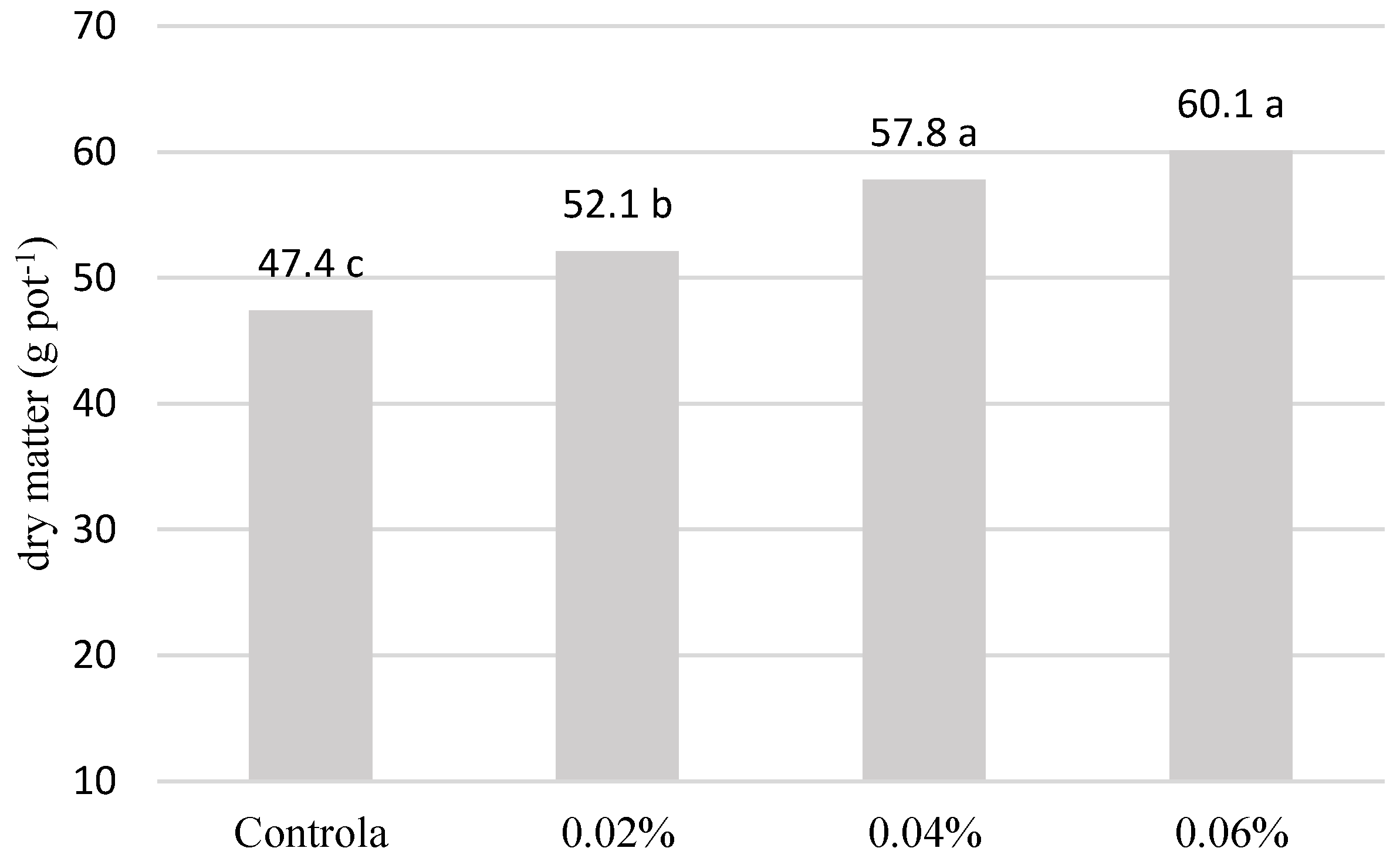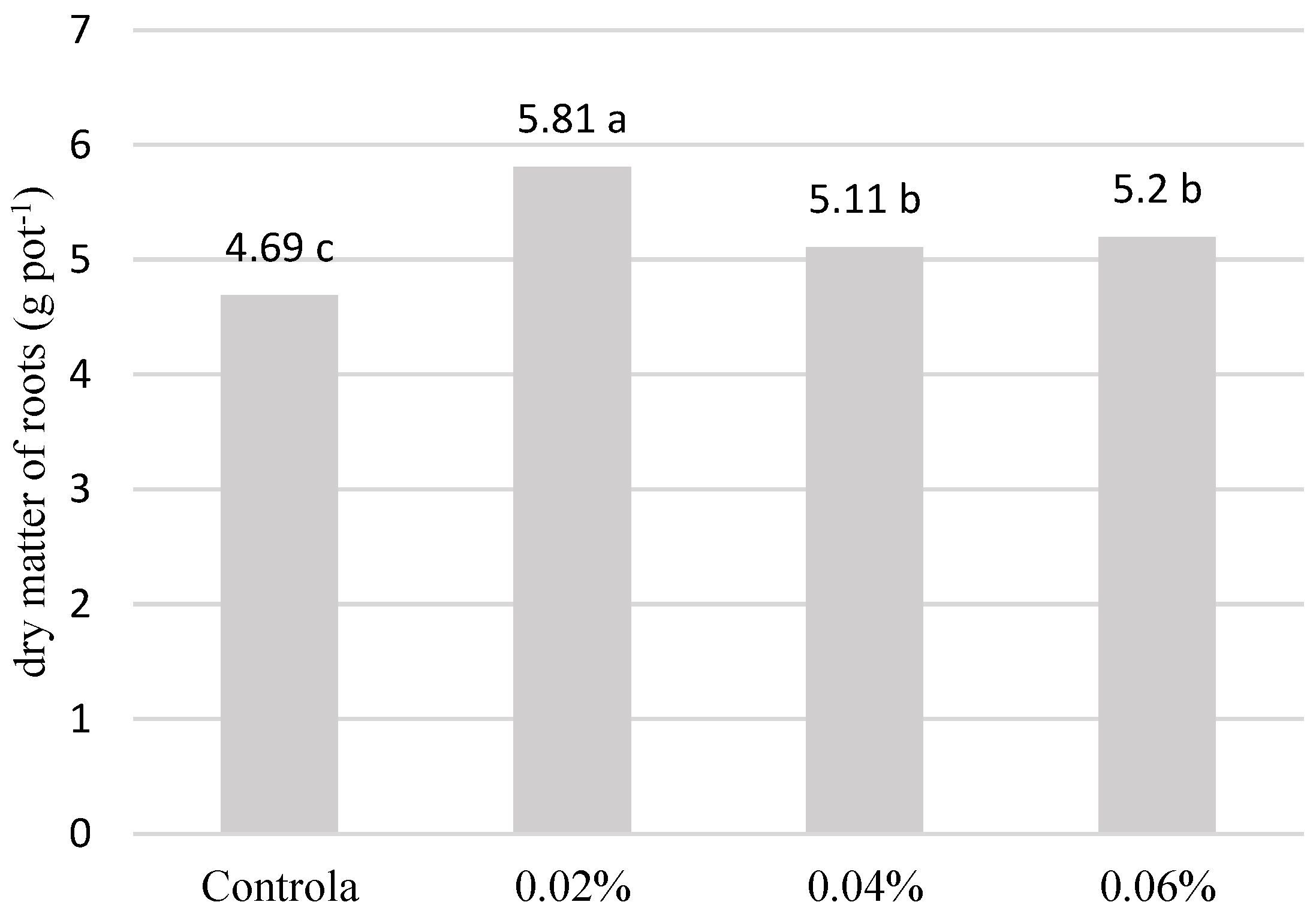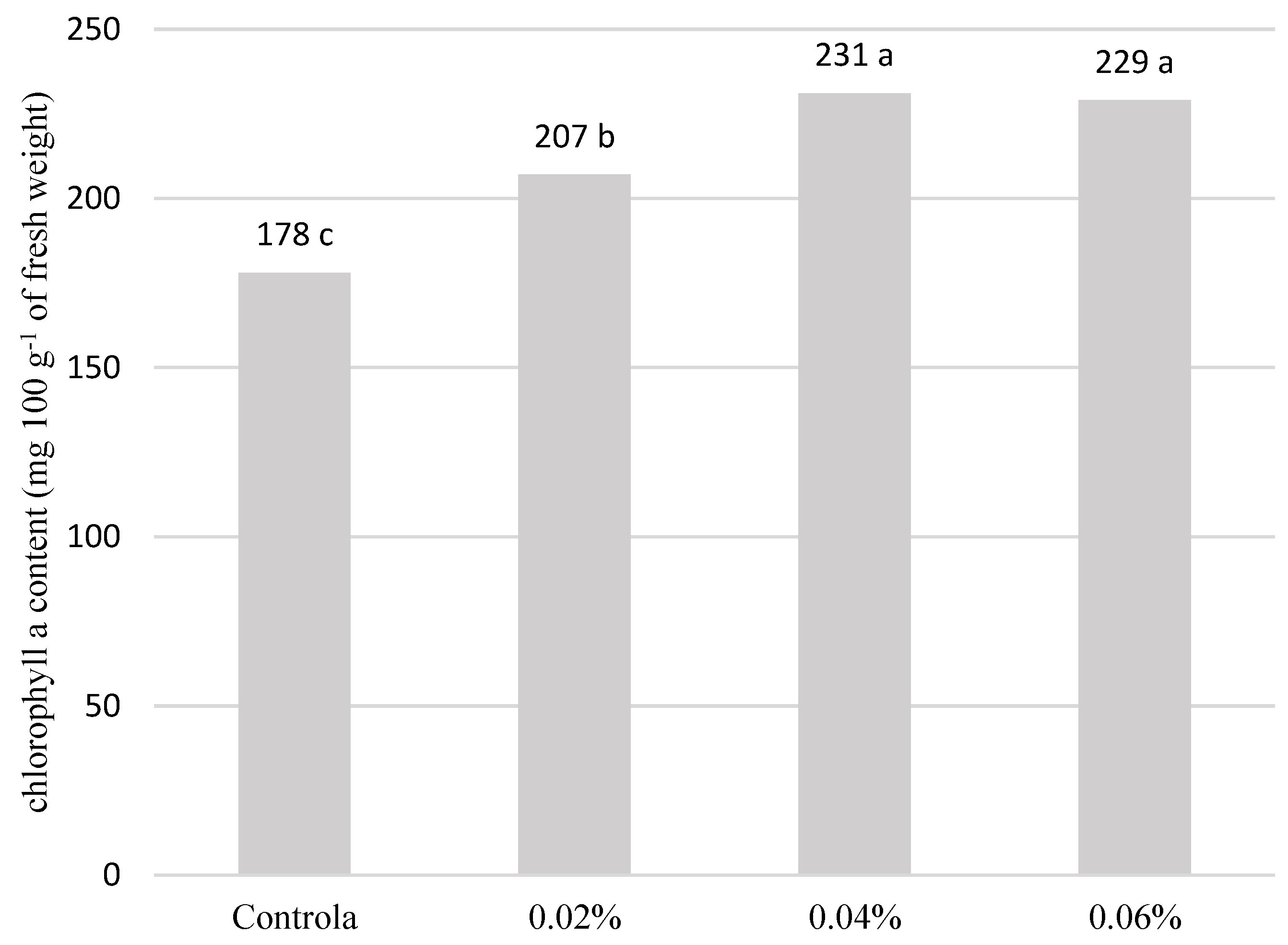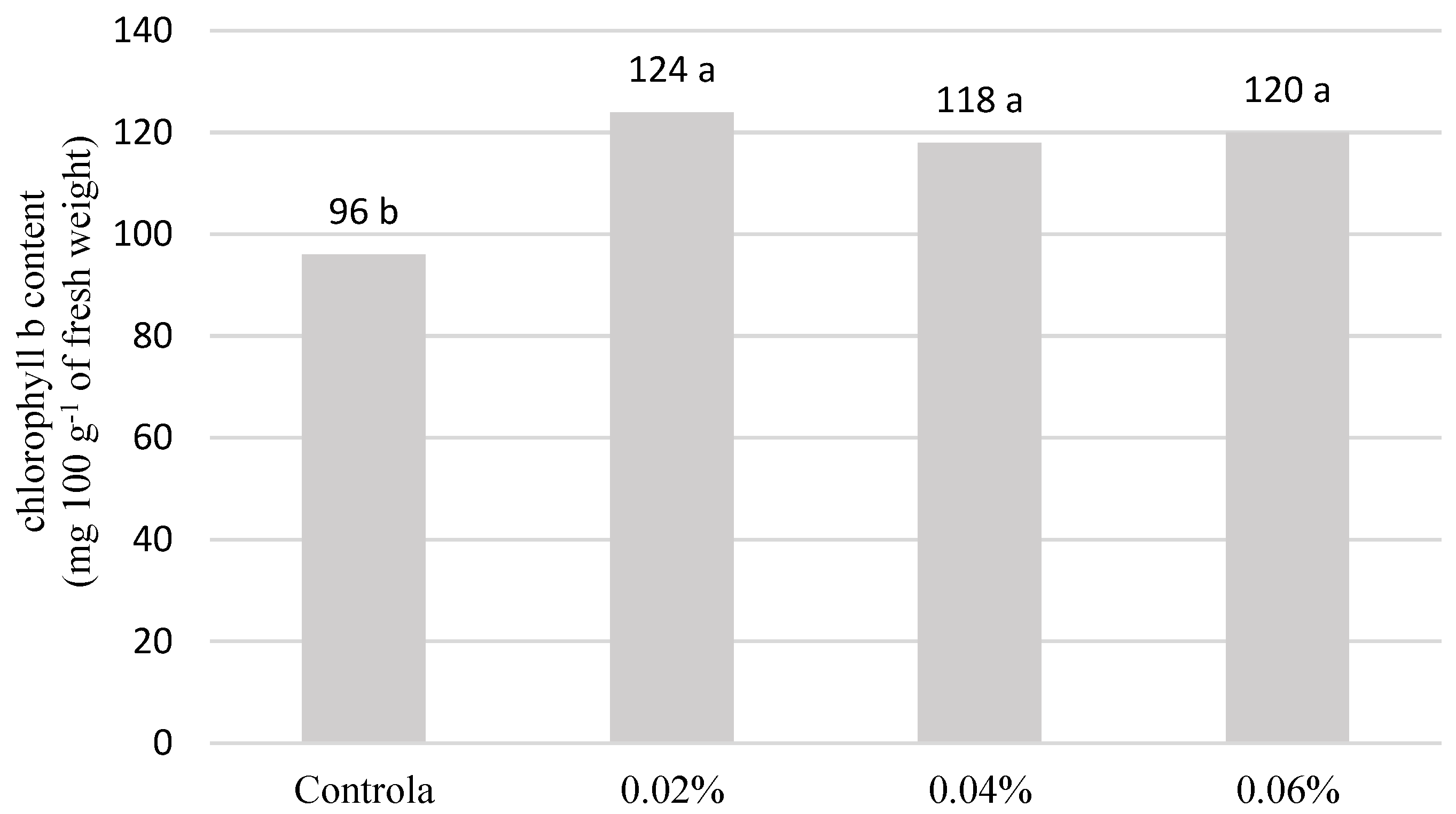Effect of Tytanit on Selected Physiological Characteristics, Chemical Composition and Production of Festulolium braunii (K. Richt.) A. Camus
Abstract
1. Introduction
2. Materials and Methods
2.1. Characteristics of the Research Site
- Particle size composition using the Bouyoucos–Casagrande aerometric method, modified by Prószyński;
- pH in a CaCl2 solution with a concentration of 0.02 mol dm−3 using the potentiometric method;
- Carbon content in organic compounds using the oxidation titration method;
- Total nitrogen content using the Kiejdahl method;
- Content of available forms of phosphorus—determined spectrophotometrically using the Egner–Riehm method;
- Content of available forms of potassium—determined spectrophotometrically using the Egner–Riehm method;
- Content of available magnesium—determined via the Schachtschabel method using flame atomic absorption spectrometry (FAAS).
- Dry weight of plant roots (g pot−1);
- Dry weight of plants (g pot−1);
- Chlorophyll a content in leaf blades (mg 100 g−1 of fresh weight);
- Chlorophyll b content in leaf blades (mg 100 g−1 of fresh weight);
- Maximum photosystem efficiency (Fv/Fm);
- Actual photosystem efficiency (ΔF/Fm′);
- Non-photochemical quenching coefficient (qN);
- Photochemical quenching coefficient (qP);
- Content of total protein, crude fiber, monosaccharides, crude fat, crude ash in plant Dry matter (g kg−1 DM) in plant dry matter;
- Content of Ca, Mg, P and K in plant dry matter (g kg−1 DM).
2.2. Chlorophyll Content Determination
2.3. Photosynthetic Activity Detppendermination
2.4. Dry Matter Chemical Composition
2.5. Statistical Analysis
3. Results and Discussion
4. Conclusions
- The highest production of Festulolium braunii (K. Richt.) A. Camus dry matter was recorded in response to 0.04 and 0.06% Tytanit concentrations. However, all concentrations positively affected the development of the plant root system. Tytanit also increased the concentration of chlorophyll pigments in leaf blades.
- Tytanit applied to green parts improved its photosynthetic activity. The stimulant increased the maximum (Fv/Fm) and actual (Fv′/Fm′) efficiency of PSII and the non-photochemical quenching coefficient (qN).
- Tytanit affected the content of organic compounds and macroelements in the dry matter of plants in various ways. Its higher concentrations increased the amounts of total protein and decreased the content of crude fiber. An increase in calcium, magnesium and potassium content was also noted. Tytanit did not affect the content of monosaccharides, crude fat, crude ash or phosphorus.
Author Contributions
Funding
Institutional Review Board Statement
Data Availability Statement
Conflicts of Interest
References
- Auriga, A.; Wróbel, J.; Ochmian, I. Effect of Tytanit® on the physiological activity of wild strawberry 280 (Fragaria vesca L.) grown in salinity conditions. Acta Univ. Cibiniensis Ser. E Food Technol. 2020, 24, 287. [Google Scholar]
- Wadas, W.; Kalinowski, K. Effect of titanium on assimilation leaf area and chlorophyll content of very early maturing potato cultivars. Acta Sci. Pol. Agric. 2017, 16, 87–98. [Google Scholar]
- Hrubý, M.; Cígler, P.; Kuzel, S. Contribution to understanding the mechanism of titanium action in plant. J. Plant Nutr. 2002, 25, 577–598. [Google Scholar] [CrossRef]
- Samadi, N. Effect of TiO2 and TiO2 nanoparticle on germination, root and shoot length and photosynthetic pigments of Mentha piperita. Int. J. Plant Soil Sci. 2014, 3, 408–418. [Google Scholar] [CrossRef]
- Michalski, P. The effect of Tytanit® on the yield structure and the fruit size of strawberry cv.“Senga Sengana” and “Elsanta”. Ann. UMCS Agric. 2008, 63, 109–118. [Google Scholar] [CrossRef]
- Borkowski, J.; Kowalczyk, W.; Felczyńska, A. Effect of spraying with Tytanit and Wapnovit on the yield and healthiness of chinese cabbage. Zesz. Nauk. Inst. Ogrod. 2017, 25, 187–195. [Google Scholar]
- Hussain, S.; Shafiq, I.; Skalicky, M.; Brestic, M.; Rastogi, A.; Mumtaz, M.; Hussain, M.; Iqbal, N.; Raza, M.A.; Manzoor, S.; et al. Titanium Application Increases Phosphorus Uptake through Changes in Auxin Content and Root Architecture in Soybean (Glycine max L.). Front. Plant Sci. 2021, 12, 743618. [Google Scholar] [CrossRef]
- Laskowska, H.; Kocira, A. Wpływ nawozu Tytanit na plon bulw acidantery dwubarwnej (Acidanthera bicolor Hochst.). Acta Agrophys. 2003, 85, 245–250. [Google Scholar]
- Grajkowski, J.; Ochmian, I. Influence of three biostimulants on yielding and fruit quality of three primocane raspberry cultivars. Acta Sci. Pol. Hort. Cult. 2007, 6, 29–36. [Google Scholar]
- Du, J.; Xu, Z.; Li, Z.; Su, Y.; Chen, Y.; Wang, X. Study progress in titanium nutrient of plants. Acta Agric. Jiangxi 2010, 1, 42–44. [Google Scholar]
- Radkowski, A.; Radkowska, I. Effect of foliar fertilization with Tytanit on the dry matter yield and macroelements’ content in the meadow sward. Ecol. Chem. Eng. A 2010, 17, 1607–1612. [Google Scholar]
- Malinowska, E.; Jankowski, K. The Effect of Tytanit Foliar Application and Different Nitrogen on Fibre Fraction Content and the Feed Value of Festulolium braunii. Agronomy 2021, 11, 1612. [Google Scholar] [CrossRef]
- Maxwell, K.; Johnson, N.G. Chlorophyll fluorescence—A practical guide. J. Exp. Bot. 2000, 51, 659–668. [Google Scholar] [CrossRef] [PubMed]
- Baker, N.R.; Rosenqvist, E. Application of chlorophyll fluorescence can improve crop production strategies: An examination of future possibilities. J. Exp. Bot. 2004, 55, 1607–1621. [Google Scholar] [CrossRef]
- Cetner, M.D.; Pietkiewicz, S.; Podlaski, S.; Wiśniewski, G.; Chołuj, D.; Łukasik, I.; Kalaji, M.H. Photosynthetic Efficiency of Virginia Mallow (Sida hermaphrodita L. Rusby) under Differentiated Soil Moisture Conditions. Int. J. Sust. Water Environ. I Syst. 2014, 6, 89–95. [Google Scholar]
- Michałek, W.; Sawicka, B. Chlorophyll content and photosynthetic activity of medium late potato varieties in arable field conditions in Central and Eastern Poland. Acta Agrophys. 2005, 6, 183–195. [Google Scholar]
- Kalaji, M.H.; Łoboda, T. Chlorophyll Fluorescence in the Study of the Physiological State of Plants; Publishing House SGGW: Warszawa, Poland, 2010. [Google Scholar]
- Lyu, S.; Wei, X.; Chen, J.; Wang, C.; Wang, X.; Pan, D. Titanium as a beneficial element for crop production. Front. Plant Sci. 2017, 8, 597. [Google Scholar] [CrossRef] [PubMed]
- Fariaszewska, A.; Staniak, M. Changes in yield, leaf area and fluorescence chlorophyll parameters of different forage grasses cultivars under drought stress. Acta Sci. Pol. Agricutura 2015, 14, 27–38. [Google Scholar]
- Angelini, G.; Ragni, P.; Esposito, D.; Giardi, P.; Pompili, M.L.; Moscardelli, R.; Giardi, M.T. A device to study the effect of space radiation on photosynthetic organizms. Phys. Med. 2001, 17, 267–268. [Google Scholar]
- Fariaszewska, A.; Aper, J.; Staniak, M.; Baert, J.; Van Huylenbroeck, J.; De Riek, J. Drought Stress-Induced Changes in Gas Exchange, Chl a Fluorescence Parameters and Yield in Lolium, Festuca and Festilolium. In Breeding in a World of Scarcity; Springer: Cham, Switzerland, 2016; pp. 69–73. [Google Scholar]
- Michalek, W.; Kocira, A.; Findura, P.; Szparaga, A.; Kocira, S. The influence of biostimulant Asahi SL on the photosynthetic activity of selected cultivars of Phaseolus vulgaris L. Rocz. Ochr. Sr. 2018, 20, 1286–1301. [Google Scholar]
- Romanowska-Duda, Z.; Grzesik, M.; Janas, R. Maximal efficiency of PSII as a marker of sorghum development fertilized with waste from a biomass bio digestion to methane. Front. Plant Sci. 2019, 9, 1920. [Google Scholar] [CrossRef]
- Sosnowski, J.; Jankowski, K.; Truba, M.; Novák, J.; Zdun, E.; Skrzyczyńksa, J. Morpho-physiological effects of Stymjod foliar application on Dactylis glomerata L. Agron. Res. 2020, 18, 1036–1045. [Google Scholar]
- Staniak, M.; Bojarszczuk, J.; Kraska, P.; Kwiatkowski, C.; Harasim, E. Prolonged drought stress induced changes in yield and physiological processesof Trifolium repens and Festulolium braunii. Biol. Plant. 2020, 64, 701–709. [Google Scholar] [CrossRef]
- Sosnowski, J.; Truba, M. Photosynthetic activity and chlorophyll pigment concentration in Medicago x varia T. Martyn leaves treated with the Tytanit growth regulator. Saudi J. Biol. Sci. 2021, 28, 4039–4045. [Google Scholar] [CrossRef]
- Arnon, D.I.; Allen, M.B.; Whatley, F.R. Photosynthesis by isolated chloroplasts. IV. General concept and comparison of three photochemical reactions. Biochim. Biophys. Acta 1956, 20, 449–461. [Google Scholar] [CrossRef] [PubMed]
- Lichtenthaler, H.K.; Wellburn, A.R. Determinations of total carotenoids and chlorophyll a and b of leave extracts in different solvents. Biochem. Soc. Trans. 1983, 11, 591–592. [Google Scholar] [CrossRef]
- Yokoya, N.S.; Necchi, O., Jr.; Martins, A.P.; Gonzalez, S.F.; Plastino, E.M. Growth responses and photosynthetic characteristics of wild and phycoerythrin deficient strains of Hypnea musciformis (Rhodophyta). J. Appl. Phycol. 2007, 19, 197–205. [Google Scholar] [CrossRef]
- Zhao, L.-S.; Su, H.N.; Li, K.; Xie, B.B.; Liu, L.N.; Zhang, X.Y.; Chen, X.L.; Huang, F.; Zhou, B.C.; Zhang, Y.Z. Supramolecular architecture of photosynthetic membrane in red algae in response to nitrogen starvation. Biochim. Biophys. Acta 2016, 1857, 1751–1758. [Google Scholar] [CrossRef] [PubMed]
- Tan, Z.; Wang, Z. Demonstration for application of “Fengtaibao”, a new water soluble titanium-containing foliar fertilizer, in potato. Chin. Potato J. 2011, 4, 234–237. [Google Scholar]
- Radkowski, A. Leaf greenness (SPAD) index in timothy-grass seed plantation at different doses of titanium foliar fertilization. Ecol. Chem. Eng. A 2013, 20, 167–174. [Google Scholar]
- Kováčik, P.; Baran, A.; Filová, A.; Vician, M.; Hudec, J. Content changes of assimilative pigments in leaves after fertilizer Mg-Titanit application. Acta Fytotechn. Zootechn. 2014, 17, 58–64. [Google Scholar] [CrossRef][Green Version]
- Khaleghi, E.; Arzani, K.; Moallemi, N.; Barzegar, M. Evaluation of Chlorophyll Content and Chlorophyll Fluorescence Parameters and Relationships between Chlorophyll a, b and Chlorophyll Content Index under Water Stress in Olea neuropaea cv. Dezful. WASET 2012, 68, 1154–1157. [Google Scholar]
- Laisk, A.; Oja, V.; Eichelmann, H.; Dall’Osto, L. Action spectra of photosystems II and I and quantum yield of photosynthesis in leaves in State 1. Biochim. Biophys. Acta 2014, 1837, 315–325. [Google Scholar] [CrossRef] [PubMed]
- Nishiyama, Y.; Allakhverdiev, S.I.; Murata, N. A new paradigm for the action of reactive oxygen species in the photoinhibition of photosystem II. Biochim. Biophys. Acta 2006, 1757, 742–749. [Google Scholar] [CrossRef]
- Chen, L.S.; Li, P.; Cheng, L. Comparision of thermotolerance of sun-exposed peel and shaded peel of “Fuji” apple. Environ. Exp. Bot. 2009, 66, 110–116. [Google Scholar] [CrossRef]
- Borawska-Jarmujłowicz, B.; Mastalerczuk, G.; Pietkiewicz, S.; Kalaji, M.H. Low temperature and hardening effects on photosynthetic apparatus efficiency and survival of forage grass varieties. Plant Soil Environ. 2014, 60, 177–183. [Google Scholar] [CrossRef]
- Yang, X.; Liang, Z.; Wen, X.; Lu, C. Genetics engineering of the biosynthesis of glycinebetaine leads to increased tolerance of photosynthesis to salt stress in transgenic tobacco plants. Plant Mol. Biol. 2008, 66, 73–86. [Google Scholar] [CrossRef]
- Kalaji, H.M.; Schansker, G.; Ladle, R.J.; Golt-sev, V.; Bosa, K.; Allakhverdiev, S.I.; Brestic, M.; Bussotti, F.; Calatayud, A.; Dąbrowski, P.; et al. Frequently asked questions about in vivo chlorophyll fluorescence: Practical issues. Photosynth. Res. 2014, 122, 121–158. [Google Scholar]
- Michałek, W.; Sawicka, B. Chlorophyll fluorescence as physiological index of potato varieties. In Proceedings of the Conference EAPR, Hamburg, Germany, 14–19 July 2002; Volume 266. [Google Scholar]
- Olszewska, M.; Kobyliński, A.; Kurzeja, M. The yield of aboveground biomass, protein and chlorophyll content in Festulolium leaves in mixtures with different proportions of Medicago Media Pers. Acta Agrophys. 2016, 23, 87–96. [Google Scholar]
- Mackiewicz-Walec, E.; Olszewska, M. Biostimulants in the production of forage grasses and turfgrasses. Agriculture 2023, 13, 1796. [Google Scholar] [CrossRef]
- Radkowski, A.; Radkowska, I. Effect of foliar application of growth biostimulant on quality and nutritive value of meadow sward. Ecol. Chem. Eng. A 2013, 20, 1205–1211. [Google Scholar]
- Wójcik, P. Vigor and nutrition of apple trees in nursery as influenced by titanium sprays. J. Plant Nutr. 2002, 25, 1129–1138. [Google Scholar] [CrossRef]
- Skupień, K.; Oszmiański, J. Influence of titanium treatment on antioxidants content and antioxidant activity of strawberries. Acta Sci. Pol Technol. Aliment. 2007, 6, 83–94. [Google Scholar]
- Kleiber, T.; Markiewicz, B. Application of ‘‘Tytanit” in greenhouse tomato growing. Acta Sci. Pol. Hortorum Cultus 2013, 12, 117–126. [Google Scholar]
- Kalembasa, S.; Malinowska, E.; Kalembasa, D.; Symanowicz, B.; Pakuła, K. Effect of foliar fertilization with Tytanit on the content of selected macroelements and sodium in celery. J. Elementol. 2014, 19, 683–696. [Google Scholar] [CrossRef]
- Wójcik, P.; Wójcik, M. Growth and nutrition of M.26 EMLA apple rootstock as influence by titanium fertilization. J. Plant Nutr. 2001, 24, 1575–1588. [Google Scholar] [CrossRef]




| Parameter | Value |
|---|---|
| Air temperature in the light-adapted state | 24 ± 2 °C |
| Air temperature in the dark-adapted state | 16 ± 2 °C |
| Soil moisture | 60% of field water capacity |
| Light intensity | 200 μmol m−2 s−1 (obtained with high-pressure sodium lamps) |
| Photoperiod | 16 h in light |
| Percentage of Earthy Fractions (Diameter in mm) | ||||||
|---|---|---|---|---|---|---|
| 1–0.1 | 0.1–0.05 | 0.05–0.02 | 0.02–0.06 | 0.06–0.002 | <0.002 | Granulometric Group |
| 48 | 11 | 13 | 9 | 10 | 9 | gl |
| Parameter | Value |
|---|---|
| pH | 6.80 |
| Corg (g kg−1 DM) | 13.5 |
| N-NO3 (mg kg−1 DM) | 1.6 |
| NH4-N (mg kg−1 DM) | 60.7 |
| Total content (g kg−1 DM) | |
| P | 0.75 |
| K | 1.12 |
| Ca | 1.80 |
| Mg | 1.20 |
| Na | 0.15 |
| General forms (mg kg−1 DM) | |
| Fe | 4562.80 |
| Mn | 156.20 |
| Cu | 5.60 |
| Zn | 14.50 |
| Content of absorbable forms (mg kg−1 DM) | |
| P–H2PO4− | 170.00 |
| K–K+ | 114.00 |
| Mg–Mg2+ | 84.00 |
| Characteristics | Tytanit Concentration | |||
|---|---|---|---|---|
| Control | 0.02% | 0.04% | 0.06% | |
| (Fv/Fm) | 0.699 (±0.09) b | 0.780 (±0.09) ab | 0.848 (±0.11) a | 0.833 (±0.11) a |
| (ΔF/Fm′) | 0.581 (±0.09) b | 0.708 (±0.11) a | 0.699 (±0.08) a | 0.688 (±0.09) a |
| (qP) | 0.611 (±0.08) a | 0.627 (±0.10) a | 0.617 (±0.07) a | 0.628 (±0.08) a |
| (qN) | 0.118 (±0.04) c | 0.134 (±0.05) b | 0.146 (±0.05) a | 0.148 (±0.06) a |
| Characteristics | Tytanit Concentration | |||
|---|---|---|---|---|
| Control | 0.02% | 0.04% | 0.06% | |
| Total protein | 148 (±17.0) b | 151 (±17.4) b | 169 (±14.6) a | 171 (±18.1) a |
| Crude fiber | 290 (±16.2) a | 274 (±11.1) b | 249 (±14.9) c | 250 (±14.6) c |
| Monosaccharides | 66.1 (±8.01) a | 67.4 (±7.74) a | 66.3 (±8.14) a | 67.7 (±9.01) a |
| Crude fat | 34.7 (±4.13) a | 34.0 (±3.93) a | 34.2 (±4.04) a | 34.9 (±5.11) a |
| Crude ash | 119 (±8.99) a | 123 (±10.7) a | 120 (±10.0) a | 121 (±10.6) a |
| Mineral | Tytanit Concentration | |||
|---|---|---|---|---|
| Control | 0.02% | 0.04% | 0.06% | |
| Ca | 18.6 (±1.79) c | 20.9 (±1.87) b | 21.6 (±2.14) a | 21.7 (±2.43) a |
| Mg | 2.31 (±0.82) b | 2.49 (±0.85) b | 3.18 (±0.88) a | 3.14 (±0.91) a |
| K | 17.1 (±1.01) b | 17.7 (±1.04) b | 19.9 (±2.10) a | 17.8 (±1.44) b |
| P | 3.49 (±0.81) a | 3.72 (±0.89) a | 3.61 (±0.94) a | 3.70 (±0.96) a |
Disclaimer/Publisher’s Note: The statements, opinions and data contained in all publications are solely those of the individual author(s) and contributor(s) and not of MDPI and/or the editor(s). MDPI and/or the editor(s) disclaim responsibility for any injury to people or property resulting from any ideas, methods, instructions or products referred to in the content. |
© 2023 by the authors. Licensee MDPI, Basel, Switzerland. This article is an open access article distributed under the terms and conditions of the Creative Commons Attribution (CC BY) license (https://creativecommons.org/licenses/by/4.0/).
Share and Cite
Sosnowski, J.; Truba, M. Effect of Tytanit on Selected Physiological Characteristics, Chemical Composition and Production of Festulolium braunii (K. Richt.) A. Camus. Agriculture 2023, 13, 2155. https://doi.org/10.3390/agriculture13112155
Sosnowski J, Truba M. Effect of Tytanit on Selected Physiological Characteristics, Chemical Composition and Production of Festulolium braunii (K. Richt.) A. Camus. Agriculture. 2023; 13(11):2155. https://doi.org/10.3390/agriculture13112155
Chicago/Turabian StyleSosnowski, Jacek, and Milena Truba. 2023. "Effect of Tytanit on Selected Physiological Characteristics, Chemical Composition and Production of Festulolium braunii (K. Richt.) A. Camus" Agriculture 13, no. 11: 2155. https://doi.org/10.3390/agriculture13112155
APA StyleSosnowski, J., & Truba, M. (2023). Effect of Tytanit on Selected Physiological Characteristics, Chemical Composition and Production of Festulolium braunii (K. Richt.) A. Camus. Agriculture, 13(11), 2155. https://doi.org/10.3390/agriculture13112155







